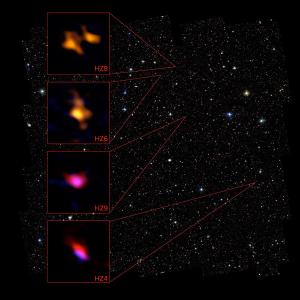Blog
Distant Carbon
3 July 2015
On a dusty day, you can’t see the smog. At least that’s how it is for galaxies, which is why the detection of carbon in early galaxies is such a big deal.
 P. Capak; B. Saxton (NRAO/AUI/NSF), NASA/ESA Hubble
P. Capak; B. Saxton (NRAO/AUI/NSF), NASA/ESA HubbleUsing data from the Atacama Large Millimeter/submillimeter Array (ALMA), astronomers have detected spectral line emissions from carbon gas in galaxies with a redshift of z = 5 to z = 6.1 This means the light we observe comes from a time when the universe was only about a billion years old. These emission lines would typically be obscured by dust in the galaxies, so the fact that they are so bright and clear means that there is little dust within these young galaxies. Carbon also tends to bind to other elements readily, so pure carbon doesn’t tend to stick around for long. And that means these galaxies are still in the early stages of star formation.
What’s particularly striking is the fact that these galaxies already appear “fully formed.” They already have much of the structure seen in older galaxies. This would imply that galactic structures form early on rather than developing gradually over time.
Capak, Peter L., et al. “Galaxies at redshifts 5 to 6 with systematically low dust content and high [C II] emission.” Nature 522.7557 (2015): 455-458. ↩︎